
Haenggungji of Buksansanseong Fortress
Designation Number : Historical Site No.479
Location : 169, Bukhan-dong, Deogyang-gu, Goyang-si, Gyeonggi-do
Haenggung is the King’s temporary lodging in emergency. On May 25 and 37th year of King Sukjong, one month before construction of Bukhansanseong Fortress, the construction of Haenggungji was first suggested by Woohang Kim who were in charge of fortress construction
According to <Bukhan-Ji> Haenggung size was total 28 kan (1 Kan = 2m), 2 kan for Naejon, 6 kan for Daecheong, and 18 kan for Samyeon-Tei.
Also, ancillary buildings such as Chung, Daemun, Suraso were 35 kan.
Wajeon had 28 kan of Jungjeon which was the same size as Naejeon. There were also ancillary buildings such as Ru, Chung, Gogan, Daemun including 12 kan of Naehaeng-Gakbang.
Although the building was preserved until the Japanese colonial period, only the site remains and it is uncertain when Hanggungji was ruined.
Fortunately, the photo of Haenggungji taken during Japanese colonial period remains and the photo shows the past shape of Haenggungji. Also, Dankook University conducted excavation and investigation on the site for precise size and characteristics.
Haenggungji was designated as Gyeonggi-do Monument No.160 and it was redesignated as historical site No.479. In 2009, integrated maintenance plan for Haenggungji was established and excavation and investigation were conducted on April, 2011.
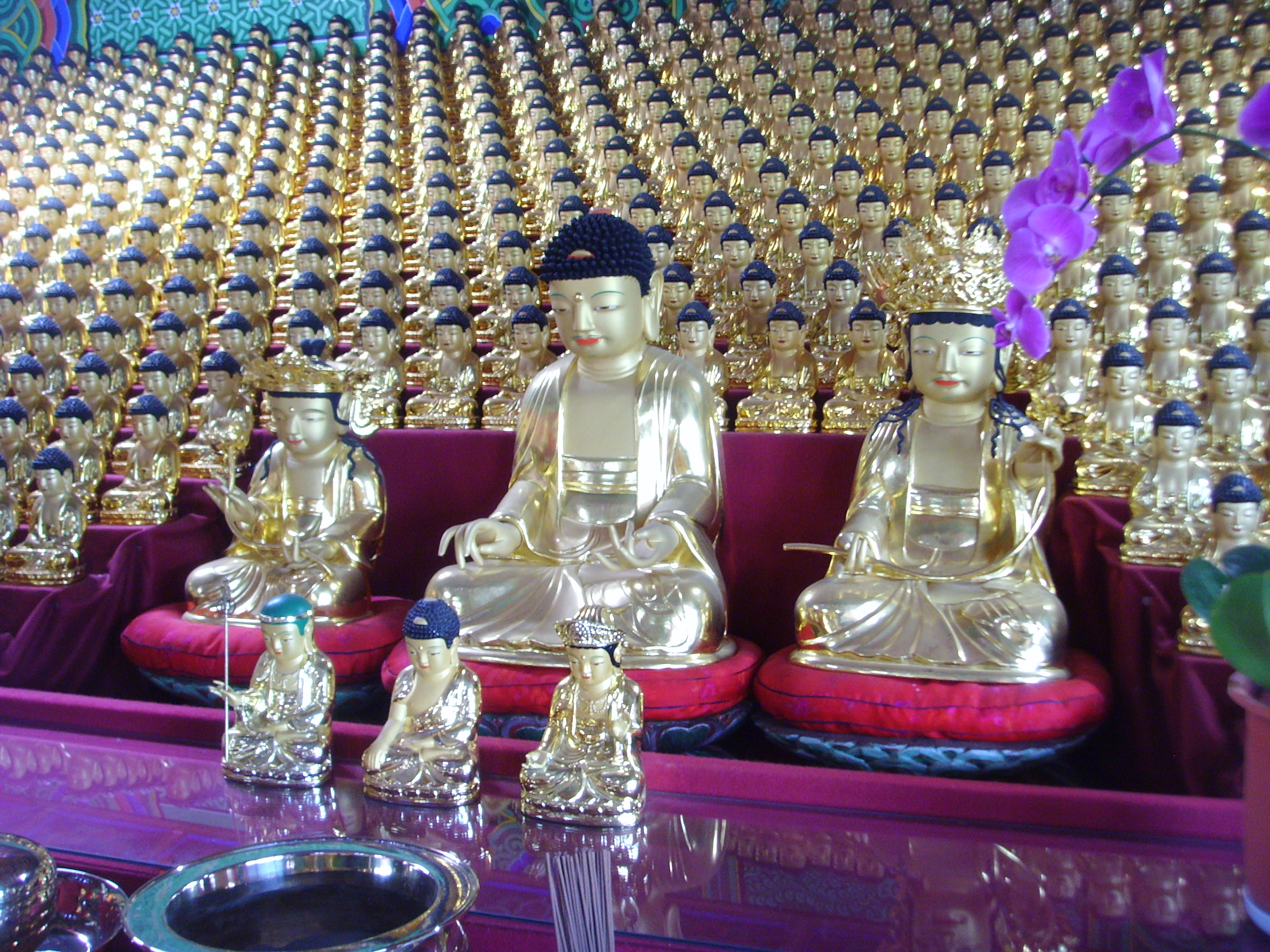
Wooden Seated Abmitabha Buddha Triad of Sangunsa Temple
Designation Number : Tangible cultural property No.190
Location : 370, Bukhan-dong, Deogyang-gu, Goyang-si, Gyeonggi-do
<
On Geungnakjeon Hall of Sangunsa Temple, a Wooden Seated Abmitabha Buddha Triad is enshrined and Avalokitesvara and Mahasthama-prapta are arranged around Amitabha.
On pedestal of Buddha Triad, prayer is written with ink. Based on the record saying ‘Building of Buddha Triad started on July 5th, 53th year of Kangxi (1713). After completion on August 6th, Buddha Triad was enshrined in Amitabha Geungnakjeon in Nojuksa Temple’. The record implies that Amitabha and Mahasthama-prapta were made in 1713.
However, Avalokitesvara has wide difference from Amitabha for its size and carving method and it is assumed that the bodhisattva was made separately.
At the bottom of Avalokitesvara, there is a record saying ‘On April 15, 1800, Avalokitesvara was was repainted with gold’. Such record indicates that the Avalokitesvara was also made before the 19th century.
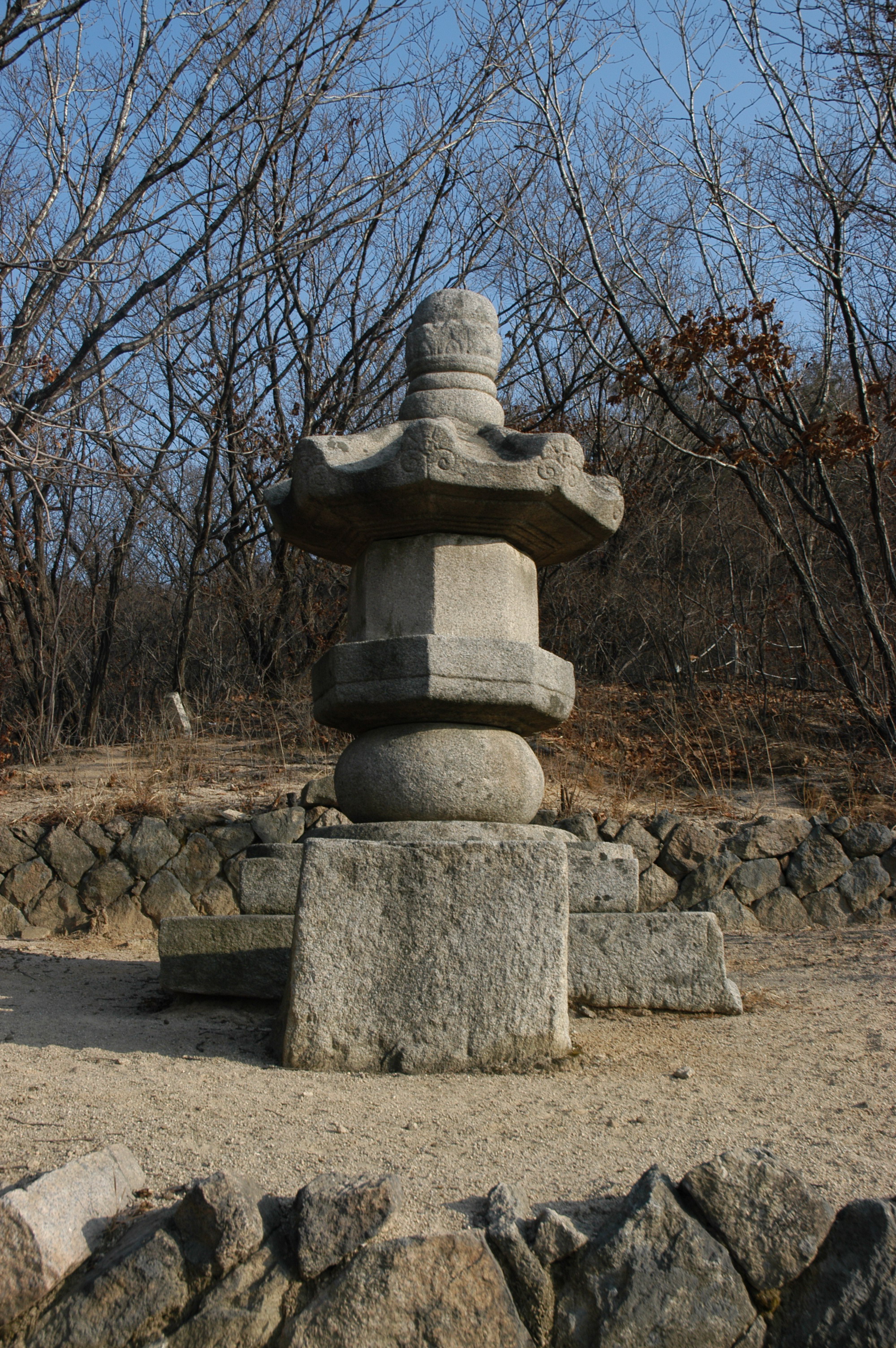
Jeon-Sung-Neung-Dae-Sa-Bu-Do in Bongseongam Rock
Designation Number : Tangible cultural property No. 188
Location : 204, Bukhan-dong, Deogyang-gu, Goyang-si, Gyeonggi-do
Jeon-Sung-Neung-Dae-Sa-Bu-Do is preserved inside the precinct, Bongseongam Rock behind Taegosa Temple, Bukhansan Mountain
Regarding structure of Seungtap, there are square-shaped bottom, middle rock and octagonal top rock on square-shaped foundation stone with four flagstones. On the stones, Seungtap is composed of octagonal body and roof rock and upper parts.
Some parts of octagonal roof rock are currently damaged and overall size is 280m.
In front of inner stylobate, you will find hexagonal stone with irregular size of 74*70*59cm. The stone is assumed to be coming off from Seungtap.
Some parts of Seungtap were damaged from bombing during the Korean War and they are currently restored. However, the restoration is not complete and some parts of the body part are lost.
Sungneung was a high monk during Joseon Dynasty and his living period is unidentified. He was also referred to as Gyepa.
Sungneung was originally a bhikkhu in Hakgasan Mountain in Gyeongsangbuk-do. Then, he trained under Gaksung in Hwaeomsa Temple for 3 years and became enlightened.
The construction of Jangryukjeon in Hwaeomsa Temple started in 1699 (25th year of King Sukjong) and it was completed in 3 years.
The time of Sungneung’s death and the reason for stopa’s exhistence in Bukhansan Mountain are unidentified. However, the Seungtap shows Sungneung’s love for Bukhansan Mountain.
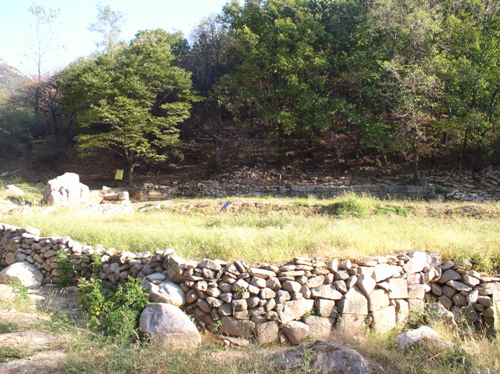
Goyang Bukhansan Mountain Seoamsaji Temple Site Protecting Floodgate of Bukhansanseong Fortress
Designation Number : Cultural property material No.140
Location : 509, Bukhan-dong, Deogyang-gu, Goyang-si, Gyeonggi-do
Seoamsa Temple is one of the 13 temples built to attract monk soldiers after construction of Bukhansanseong Fortress.
The size of Seoamsa Temple is 133 kan (1 kan = 2m) and the temple was built by monk Gwang-Hun. As there were site where Moon-In-Gong Min-Ji
Seoamsa Temple was in charge of protecting the mountain fortresses in floodgate regions. It is assumed that Seoamsa Temple went out of use in the late 19th century.
On each gate of Bukhansanseong Fortress, temples were built for the purpose of security and protection.
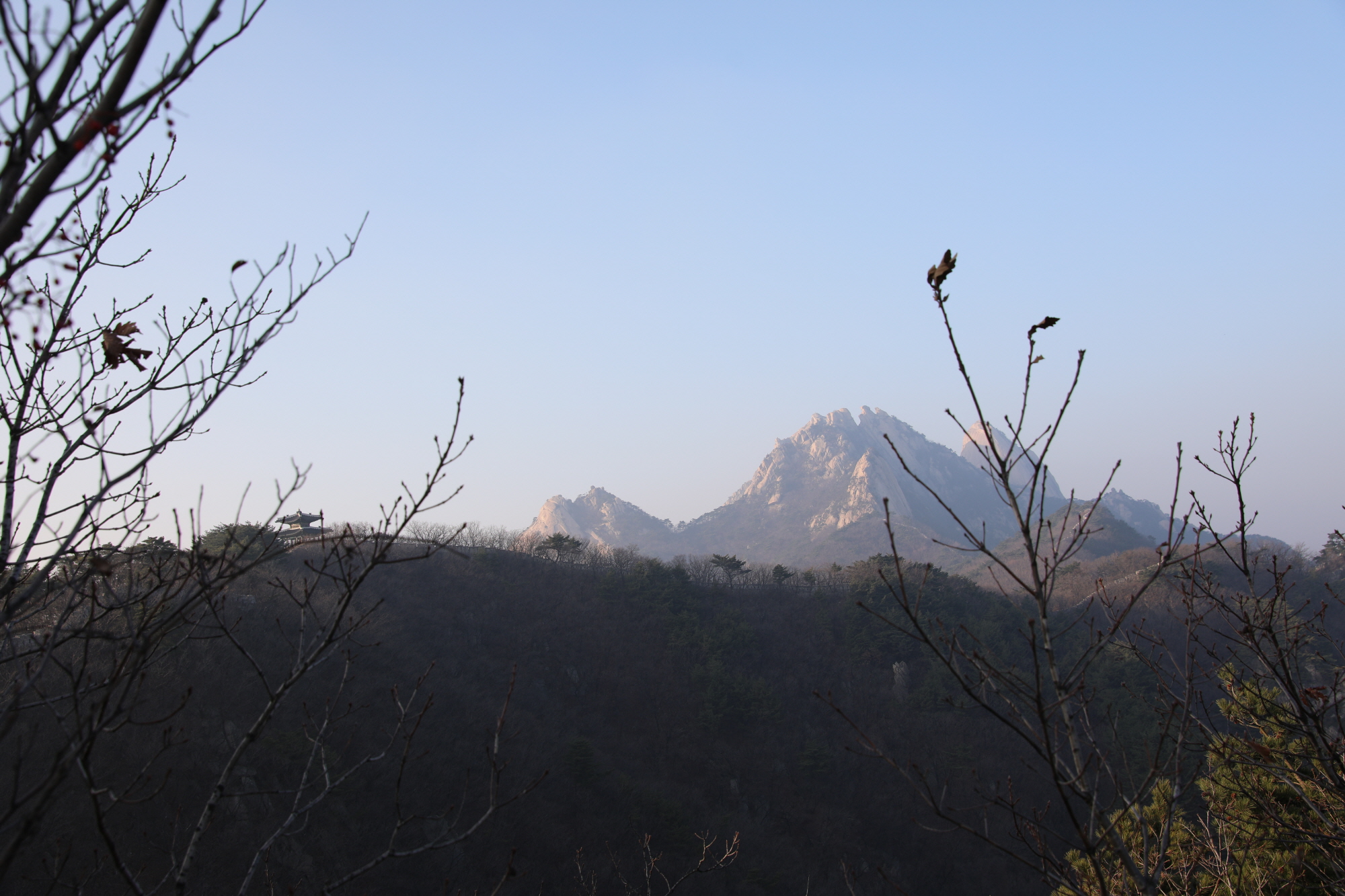
The Pride of Bukhansan Mountain, Bukhansanseong Fortress
Designation Number : Historical site No. 162
Location : Mountain 1-1, Bukhan-dong, Deogyang-gu, Goyang-si, Gyeonggi-do
Currently, Bukhansanseong Fortress is designated as historical site No.162.
Bukhansanseong Fortress was constructed by the order of King Sukjong in 1711. At present, Bukhansanseong Fortress stretches from Goyang-si to Seoul.
The total perimeter is 12.7km and 8.4 km when natural rocks are excluded.
The area of regions inside the fortress is about 6.2㎢ and its about 3/4 size of Yeouido
Samgaksan Mountain is located in the northeast of Bukhansanseong Fortress and it is designated as the scenic spot No. 10. The gross area is 274,143㎡ and most of the areas belong to Goyang-si
Bukhansanseong Fortress has over 200 cultural properties and current condition of 71 cultural properties are identified.
there are 5 state-designated cultural properties and 6 province-designated cultural properties.
Bukhansanseong Fortress has cultural properties that still needs to be identified.
The features of Bukhansanseong Fortress are as follows.
First, accessibility.
When you take a look at the old maps and drawing about regions around Bukhansanseong Fortress, you will notice that Seoul Fortress Wall and Bukhansanseong Fortress are connected by Tangchundaeseong Fortress (made to connect Fortress Wall of Seoul and Bukhansanseong Fortress).
Due to such features, people could move quickly through the road in the event of emergency.
Second feature is the defensive power.
Anyone who climbed Bukhansan Mountain would agree that roads for going up the ridge of Bukhansan Mountain are rough.
The third feature is Bukhansanseong Fortress’s best scenic spot.
Bukhansanseong Fortress has state-designated cultural property scenic spot No.1.
In the middle of Bukhansan and northeast of Bukhansanseong Fortress, you will see the center of Bukhansan, Samgaksan Mountain.
In Samgaksan Mountain, Baegundae Peak, Insubong Peak, and Mangyeongdae Peak form three mountain peaks.
The fourth feature is the preservation of past shape.
Although it is said that some parts of the Bukhansanseong Fortress were reconstructed during the period of King Jungjo and and King Sunjo, most of the fortress were actually constructed in 1711 during the period of King Sukjong.
The fortresses constructed during the period of King Sukjong still have their original shapes.
Bukhansan Mountain is listed in the Guiness Book of World Records for the most visited mountain per unit area.
Bukhansan Mountain is also well-known for national park nearest to the capital in the world.
Many people don’t notice the preciousness of Bukhansan Mountain since they can visit the mountain anytime. How about thinking about Bukhansan Mountain and its preciousness?
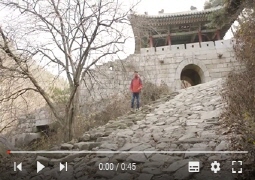
Jungsungmun
This is Jungsungmun located between Daeseomun and Haenggung.
This gate is called Jungsungmun since it’s located in the middle.
This door passing Jungsungmun is the King Sukjong Road famous for its richest historic sites and beautiful roads in Bukhansanseong Fortress.
King Sukjong Road got its name as King Sukjong often visited this place.
The front gate over there on the left side is for live people. This door on the right side is also referred to as Sibumun as the dead body of residents or soldiers in Bukhansanseong Fortress passed the door.
Click to play the video.
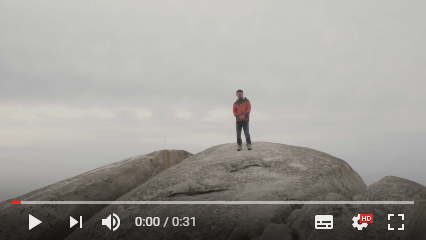
Bukhansanseong Fortress
In Bukhansanseong Fortress, fortresses are made around Baegundae Peak of altitude 836.5m between Mangyeongdae on the right side and Youngchuibong Peak on the left side.
The total length of fortress is 12.7km. This fortress was constructed around 300 years ago during the period of King Sukjong and it took 6 months for construction.
This wide and huge fortress was within 6 months.
Click to play the video.
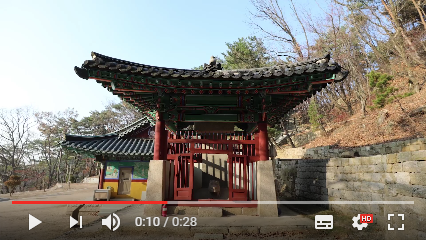
Taegosa Temple
Taegosa Temple in Bukhansan Mountain has stone monument stupa of Wonjung Guksa and the stone monument is designated as the national treasure.
This is the famous inscription composed and written by Mokwon Lee-Sek
Wonjung Guksa in this Tegosa Temple is the father of all Buddhisms in Korea.
Click to play the video.








